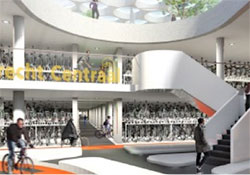WHO welcomes Utrecht into the Healthy Cities Network

Gemeente Utrecht
Installation of over 30 water taps around the city; community vegetable gardens; environmentally friendly scooters; and the construction of the world’s largest indoor bicycle park, housing up to 12 500 bicycles – these are just a few of the initiatives taken by the city of Utrecht, the Netherlands, to improve the health of its citizens.
Recognizing Utrecht’s progress, WHO welcomed the area into its Healthy Cities Network at the meeting entitled “Environment and Health for European cities in the 21st century: making a difference”, held in Utrecht on 13–14 December 2016.
“WHO warmly congratulates Utrecht on joining the WHO Healthy Cities community. Its efforts to provide citizens with ever-improving quality of life, health and well-being by mobilizing every policy sector of its city council are to be applauded,” said Dr Srđan Matić, Coordinator, Environment and Health, Division of Policy and Governance for Health and Well-being at WHO/Europe. “We hope it will inspire many other cities to follow its example.”
Meeting participants were introduced to the tools and resources developed by WHO, city networks and authorities to enhance collaboration between European cities and local authorities, national governments and relevant international organizations within the framework of the European Environment and Health Process.
Cities as opportunities for health
With more than 80% of Europeans expected to live in urban areas by 2030, rapid ageing of the population, the growth of noncommunicable diseases and increasing migration, the urban environment presents a set of pressures on the health of the WHO European Region’s inhabitants.
Despite these challenges, cities can also provide opportunities to protect and enhance health and well-being. Through local action and partnership, they have the potential to strengthen health systems across different sectors; address obesity and the noncommunicable diseases epidemic; and help prepare for the effects of climate change. At the same time, they can improve local environmental conditions – for example, air quality– making their communities better places to live and invest, and addressing social inequalities.
A total of 70–80% of public investments in Europe are made by local and regional authorities. In times of economic downturn, city governments can play a key role as advocates and guardians of the health needs of the people who are most vulnerable and socially disadvantaged.
Cities have been identified as a priority area under the Sustainable Development Goals (SDGs), particularly SDG11: Make cities inclusive, safe, resilient and sustainable. They are also one of the emerging priorities for the European Environment and Health Process.
Cities as theme for Sixth Ministerial Conference on Environment and Health
At the meeting in Utrecht, representatives of cities and local authority networks, intergovernmental organizations, agencies and Member States reviewed examples of innovative policies and actions undertaken by European cities and regional authorities to address environment and health challenges. These would inform the preparations of the upcoming Sixth Ministerial Conference on Environment and Health, to be held in June 2017.
The theme of environment and health for European cities has been identified as one of the new priorities for the European Environment and Health Process. The Process is an international policy platform, which since 1989 has brought together the ministries of health and environment of the 53 Member States in the WHO European Region to address environment and health challenges through intersectoral policies.



